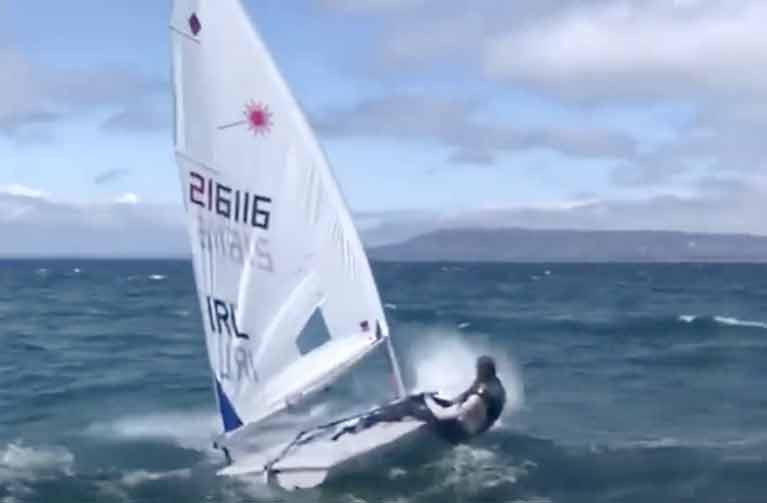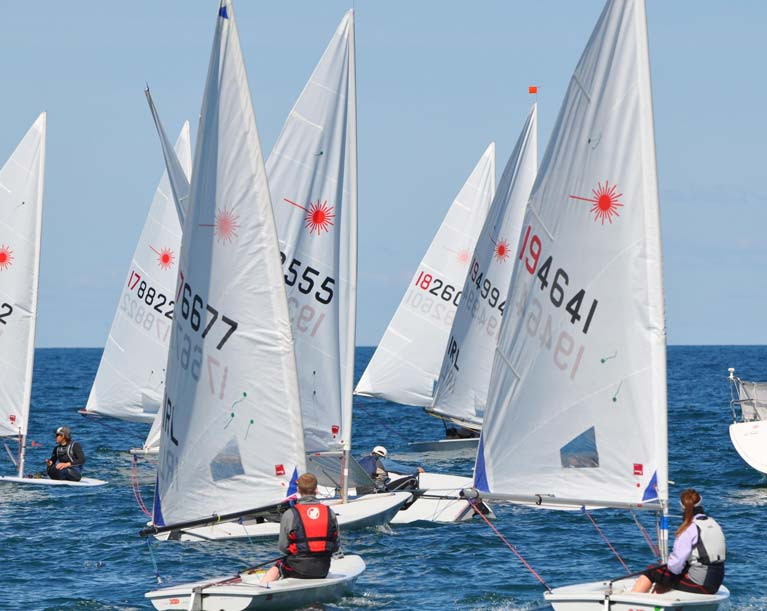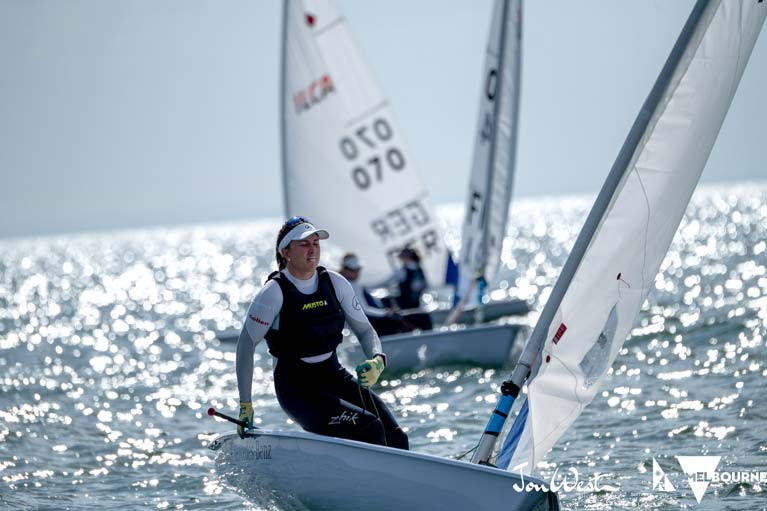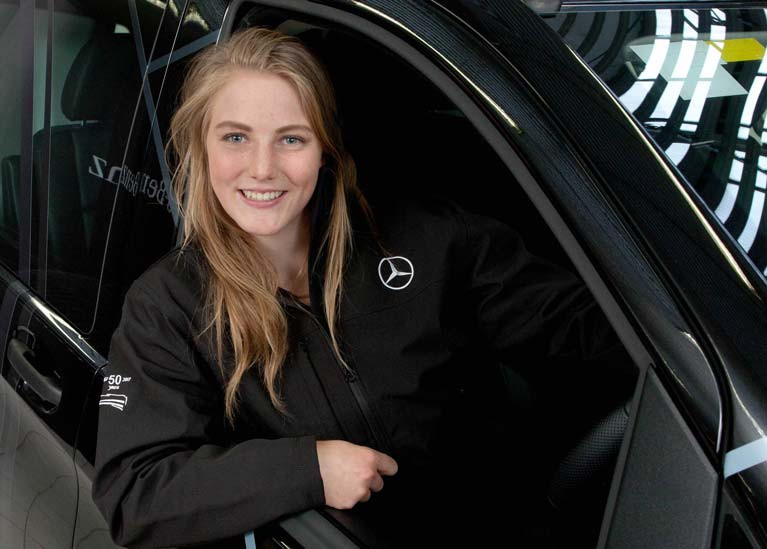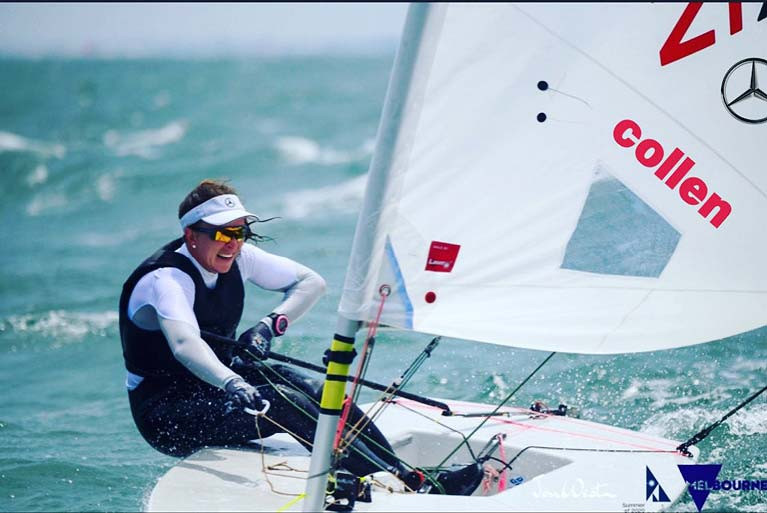Displaying items by tag: Radial
New Video Shows Howth Youth Laser Star Eve McMahon in Action
A new sailing video of youth Laser Radial star Eve McMahon gives a clear understanding of why the Howth Yacht Club ace was awarded the 2019 Irish Youth Sailor of the Year Award in February.
The video below prepared for HYC members also gives an interview with the rising star who is one of four sailors seeking the Irish Radial nomination for the Tokyo Olympic Regatta, a trial that sees her up against Olympic silver medalist Annalise Murphy.
McMahon had an outstanding 2019 season becoming Irish youth national Radial Champion at Royal Cork in May 2019 before going on to take the Under-17 World title in Kingston, Ontario in August, also impressively finishing 3rd in the overall competition.
She was certainly the in-form competitor at the World Championships in Melbourne in February this year, where she won the Gold Medal again in the U17 event.
Advancing to senior competition at 15 years-of-age is one thing but Eve has taken this a step further with her involvement in the Olympic trials, a campaign that should prove invaluable for her long-term career prospects on the international sailing circuit, not least for her ambition to advance to Olympic competition level. Eve made the most of her Transition Year by linking up and training with the Irish Olympic squad, battling back from injury and showing a determination and grit that will undoubtedly stand to her in the future.
In a first for Irish Sailing, the 2021 trialists now feature McMahon siblings in two classes with Eve’s older brother Ewan competing in the men’s Laser class and with Olympic qualification in his sights.
Eve took some time out before the COVID-19 'lockdown' to post a video on youtube to tell HYC members of her year and her plans ahead in a specially recorded interview with her other brother Jamie. The interview is below.
Ballyholme's Laser Radial Euros Latest to Fall to COVID-19
Ballyholme Yacht Club was to have been the venue in early July for the huge Laser Radial European Championships but the Iatest news from the EurILCA team is that due to the COVID-19 situation and expected restrictions on travel during July and possibly August (and to help allay fears of people having to travel abroad during those months), EurILCA and Ballyholme Yacht Club have come to the very difficult decision to cancel the event this summer. This will hopefully allow EurILCA enough time to try and reschedule it elsewhere possibly in October or November at a different “warmer” venue.
Although there is virtually year-round dinghy racing at Ballyholme, the weather is too unpredictable in the Autumn for a week-long championship and the days are too short to fit in the necessary number of races.
Ballyholme has said thank you to all who applied to race there this summer; “Hopefully you will get the chance to come here in the future for a different event, or just come here on holiday – we are always happy to welcome other sailors to our club”.
In a message from EurILCA they said: “Dear sailors, due to the situation with the COVID-19, it is with great regret that Ballyholme Yacht Club and EurILCA have decided to cancel the event”.
Ballyholme Yacht Club and its volunteers have been preparing for months for this event and EurILCA has thanked them for the effort, time and energy they put in the preparation. BYC are bidding for the same event in 2023 and the EurILCA is working to find a new location to hold this 2020 event later in the season - maybe October or November 2020.
In a message, this morning event chairman Mark Mackey said “Thank you to all our supporters and volunteers who have worked on this over the past 18 months to set up what should have been a fantastic event. And to those who had already volunteered to help during the weeks of the event -there are too many to single out by name – events like these can use well over 100 volunteers – but thank you".
Irish Olympic Laser Radial Trial to be Rescheduled as Trofeo Princesa Sofia is Scrubbed
Qualification events that lead to the Tokyo 2020 Olympics are being greatly affected this week by the world Coronavirus crisis. The second of three Irish Olympic Laser Radial trials due to be sailed as part of the 2020 Trofeo Princesa Sofia on March 30 to April 4 in Mallorca has been cancelled.
As late as yesterday, the Spanish organiser was pressing ahead with the event, issuing a breathless press release advising "already several hundreds of sailors are training in the waters of Mallorca to prepare for this regatta".
24 hours later, however, it's the second major Olympic classes regatta to be cancelled this week after the Genoa World Cup was pulled on Wednesday.
“We deeply regret this situation but we must follow the restrictions requested by the Authorities to face this world health issue,” said the event statement.
As Afloat previously reported, held on the Spanish island of Mallorca, this event in the Mediterranean Sea is the traditional start of the European season for Olympic classes.
The cancellation of the Trofeo Princesa Sofia Iberostar also triggered the postponement of the 2020 470 Class World Championship that were to be held March 16-21 in Palma, Mallorca.
National Yacht Club's Annalise Murphy Widens Gap on Irish Olympic Radial Rivals at World Championships
Annalise Murphy (NYC) recovered from a U flag disqualification in Race 7 of the ILCA Laser Radial World Championship in Melbourne to score second-place finishes in Races eight and nine to lie eighth overall.
In doing so she widened the Olympic selection gap on her nearest rival Aoife Hopkins (HYC) who now lies 45th overall. Other Irish contenders, Aisling Keller (LDYC) and Eve McMahon (HYC) are in eighth and 23rd places respectively in the silver fleet.
More moderate winds were still shifty and many leading contenders had a high score today. Defending champion Anne-Marie Rindom (DEN), now third overall commented that “It was a tough day, the shifts were hard to predict, one mistake and you get punished.”
With one more drop race to come, Murphy can still progress up the leaderboard but is unlikely to catch her fellow Rio medallist, Marit Bouwmeester (NED) who has a 24 point lead.
Three races are scheduled for tomorrow, with moderate to fresh southwesterly winds forecast.
Full results are here
200 Applications for Laser Radial Youth European Championships at Ballyholme Yacht Club
Preparations are well underway for the Laser Radial Youth European Championships to be held at Ballyholme Yacht Club this summer from 5th to 11th July 2020.
Over 200 applications have been received from across the world already - although this is a European Championships with entries from 18 European countries so far, there is also an open event with an 11 strong USA team conspicuous amongst other entries from Australia, New Zealand, Peru, Guatemala, Canada, Netherlands Antilles and the US Virgin Islands.
Local interest includes Ballyholme sailor Dan McGaughey who was Irish Youth Sailor of the year in 2018 and is currently training with the GBR squad despite the extra travelling required. The Irish squad though is strong as evidenced at the Irish Laser Nationals last summer when Michael O’Sulleabhain won ahead of Tom Higgins, Dan and a number of visiting UKLA sailors.
Irish ladies will be focussing on Howth’s Eve McMahon who despite only turning 16 recently is trialling for the Tokyo Olympics this week in Melbourne Australia at the 2020 Laser Radial Worlds against 3 seniors including Rio Silver Medallist Annalise Murphy. Eve won the Under 17 section of the Laser Radial Youth Worlds in Canada last summer. Also sailing in Melbourne are 3 Australian girls who are heading to Ballyholme - Eve is ahead of them at the midway point in the regatta.
Sailors are expected to arrive from as early as Friday 26th June with a number including the GBR squad looking to take part in the Laser Ulster Championships on the weekend of 27th/28th June at County Antrim Yacht Club, Whitehead. This event should allow sailors to acclimatise with their first views of Belfast Lough and what to expect weather-wise - their race arena is on the northern side of Belfast Lough opposite Bangor.
The Championships are expecting to host 250 to 350 sailors.
Annalise Murphy Scores Ninth as Weather Hampers Radial Worlds in Melbourne
The National Yacht Club's Annalise Murphy finished ninth in the blue fleet to lie 45th overall and leads Irish hopes on day two of the ILCA Laser Radial Women’s World Championship in Melbourne.
Once again the weather gods did not look favourably on Port Philip Bay in Victoria, Australia as only one of three scheduled races was completed.
An 11-13 knot wind was favourable for Rio silver medallist Annalise Murphy finishing 9th in the blue fleet to lie 45th overall. Eve McMahon (HYC) (yellow fleet) who lead the trials on day one, could only manage a 31st to add to her first race 20th to lie 52nd overall. A better day for Aoife Hopkins (LDYC) in the yellow fleet who added a 10th to her first day 45th to lie 55th overall. Aisling Keller (LDYC) placed 18th in the blue fleet and is now 60th overall.
Tuesday could prove difficult for completing the scheduled three races. Light and shifty winds are forecast until mid-afternoon. However, the pattern is predicted to settle for Wednesday and Thursday which should allow the organisers to catch up with the programme.
While discards will not kick in until after race four, the Irish sailors will need to ensure gold fleet (top 52) to minimise the points they will carry into the 2nd trial in Palma next month.
Early Boost for Howth Yacht Club's Eve McMahon in Irish Olympic Laser Radial Trial
Dublin teenager Eve McMahon's bid for the Tokyo Olympics got a boost today when she finished top of four Irish girls competing in the opening day of the Laser Radial World Championships in Melbourne.
Light and flukey winds frustrated competitors and race officials alike, allowing for only one of the scheduled two races on Port Philip Bay.
McMahon (HYC) was best of the Irish finishing 20th in the yellow fleet, ahead of Aoife Hopkins (HYC) in 45th place. In the Blue fleet, Annalise Murphy (NYC) recorded a 38th place, while Aisling Keller (LDYC) came 42nd. Read Afloat's championship preview here.
Defending titleholder Anne-Marie Rindom (DEN) took first place in Yellow Fleet while Marie Barrue (FRA) won Blue Fleet.
“It was a bit light,” Anne-Marie said of the conditions. “The change didn’t really come through.” But 12 races are scheduled for the regatta. “It’s early days, but it’s a good way to start,” she added.
Yellow Fleet had the better of the weather, getting away shortly after the scheduled start time in six knots of breeze and managing to finish before the wind began swinging wildly.
Those in Blue Fleet had a frustrating day, with their race abandoned at the first mark owing to a 30-degree shift. It is an ill wind that blows nobody any good and Australian Olympic hopeful, Mara Stransky, said she was caught too far left in a poor position when the abandonment came. She regrouped and finished the re-started race in fifth position. “I’m happy after such a whacky day,” she said.
Olympic champion, Marit Bouwmeester (NED) finished in third place in Blue Fleet and described it as ‘OK’. “It’s a nice way to start the event,” she said. “The race committee had a challenging day with all the wind shifts, but it’s good to get one race in, to get the regatta started.”
Maud Jayet (SUI) and Vasileia Karachaliou (GRE) share third place overall after finishing second in their respective fleets.
The ILCA Laser Radial Men’s World Championship is being sailed at the same venue, with the fleet dominated by Australians. But it was a Russian, Daniil Krutskikh, who won today’s race, followed by locals Michael Compton and Jordan Makin.
Like the women’s Blue Fleet, the men had several re-starts and abandonments before getting their first race off, and completed.
With light winds forecast for tomorrow morning, the race committee has announced a first signal be at 2 pm, as scheduled. If the winds settle as forecast, they will try to get three races sailed to get the regatta back on schedule.
Provisional Results after Day 1
Laser Radial Women’s Worlds
1 – Marie BARRUE (FRA) 1
1 – Anne-Marie RINDOM (DEN) 1
3 – Maud JAYET (SUI) 2
3 – Vasileia KARACHALIOU (GRE) 2
5 – Marit BOUWMEESTER (NED) 3
5 – Svenja WEGER (GER) 3
7 – Mirthe AKKERMAN (NED) 4
7 – Marie BOLOU (FRA) 4
9 – Sarah DOUGLAS (CAN) 5
9 – Mara STRANSKY (AUS) 5
Howth Radial Sailor Aoife Hopkins Gets Mercedes Benz Support for Tokyo Trial
21-year-old Olympic sailing hopeful, Aoife Hopkins will attempt to qualify for the forthcoming 2020 Olympic Games in Tokyo this month and is supported in her bid by Mercedes-Benz.
From Howth, Aoife has been sailing since the age of nine and has held the Women’s Laser Radial Irish national champion and under-21 European champion titles, amongst other accolades.
The first of three Olympic trials for Irish selection, the World Championships, will see Aoife compete in Melbourne, Australia.
While sailing is the main priority at the moment, balancing study and sport is a talent Aoife has learned to master over the years. Recently, the Howth Yacht Club star became a University College Dublin financial maths student, having previously studied at Trinity College Dublin for two years.
With Ireland having secured one of the last places in the Laser Radial class at the Tokyo 2020 Olympic Games and with four sailors now set to contest a trials series for the single place, the Irish Sailing procedures for the 2020 Olympic Games Trials have been ratified by the Olympic Federation of Ireland and are downloadable below as a PDF document.
Ireland’s Laser Radial Olympic Berth
As Afloat previously reported, a three trial regatta series will be used to identify the Irish Sailing Team nominee. The following trial regattas will be used for the Laser Radial Class:
- ILCA Laser Radial Women’s World Championship, Melbourne, Australia, 21-28 February 2020 (this replaces the Genoa WC Round 2020)
- Trofeo Princesa Sofia, Palma, Spain. 28 March – 4 April 2020
- Hyéres Regatta, France, 18 – 25 April 2020
Lasers and 49ers Chasing Final Olympic Places
While neither the Laser Men or the 49ers have yet secured country qualification, both will compete in Genoa this April at the European qualifier with two final Olympic places available in the Laser class and one in the 49er. Whoever qualifies Ireland for an Olympic spot will automatically represent the nation in Tokyo this Summer.
Download the full nomination document below.
Howth Yacht Club's Eve McMahon Adds Another U17 Gold in Laser Radials
Eve McMahon of Howth Yacht Club, current Gold Medal holder in the Laser Radial U17s World League after success in Canada last summer, has added yet more valuable metal to her collection by emerging as U17 Gold Medal winner in this week’s Sail Melbourne Regatta, in which a total of 85 Lasers took part.
Top overall performance for Ireland (as already reported in Afloat.ie) was put in by the National YC’s Annalise Murphy, who took Silver in the Overall Women’s Division.



























